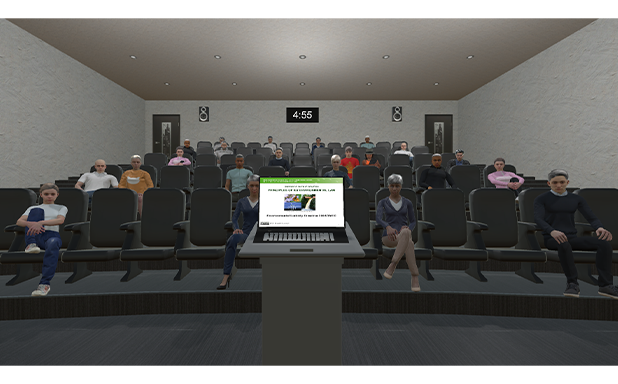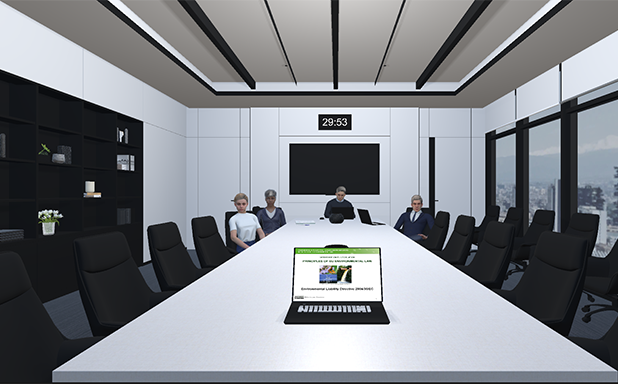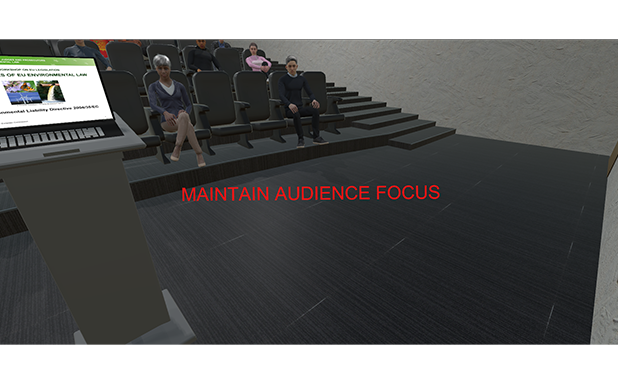Researchers from Brunel University London have used virtual reality to support people with speech anxiety and a fear of public speaking. A new application called PublicVR was uploaded to VR headsets to allow participants to deliver presentations in virtual reality boardrooms and auditoriums in front of an audience of 3D avatars. Messages would appear throughout the presentations praising participants and providing them with instant feedback about their pace and gaze.
The fear of public speaking is a social anxiety disorder also known as glossophobia. It is one of the world’s most common fears and affects 75% of the population. The disorder can affect people both physically and psychologically, resulting in a dry mouth, increased blood pressure, sweating and a fear of humiliation or embarrassment.
For this new study, researchers from Brunel University London and the University of Greenwich used Virtual Reality Exposure Therapy (VRET) - an emerging technology aimed at improving anxiety disorder symptoms - to support adults with self-reported public speaking anxiety. The intervention aimed to improve four specific non-verbal communication skills: peer anxiety, stage fear, lack of confidence and shyness.
Dr Damon Daylamani-Zad, a Senior Lecturer in Digital Media from Brunel University London, who worked on the study, said: ‘Through Virtual Reality Exposure Therapy, a patient can be gradually exposed to the scenario or environment they fear while being immersed in virtual reality.”
The VRET intervention took place at Brunel and Greenwich and involved participants aged between 19 and 25. Before the study, the participants all completed a questionnaire that determined their level of public speaking anxiety. Two groups of participants were identified from the data, those with moderate to high anxiety and those with low levels of anxiety.
On arrival to the intervention, each participant was given a laptop that contained five preloaded slides and notes on the same presentation topic, which was the Principles of EU Environmental Law. They were all given 10 minutes to familiarise themselves with the slides before delivering three 5-minute presentations in virtual reality.
The three presentations were delivered under three different virtual conditions that varied in layout (auditorium or boardroom), formality (determined by the audience’s dress and posture) and capacity (size of the audience). Once the VR headset was on, participants were immersed in virtual reality, which included a laptop and their five slides, which they could navigate using a VR remote controller.
Examples of possible virtual reality settings


The first condition was in an informal setting with a small audience (1-8 people); the second was in an informal setting with a medium audience (9-35 people); and the third was in a formal setting with a large audience (more than 35 people).
During the presentation, the participants could see a timer counting down their 5 minutes, and bold feedback messages would appear. “We were focussed on getting the participants to share their gaze and to look up and around,” explained Dr Daylamani-Zad. “If they became fixated on a specific area or corner, they would get a message to inform them that they had been looking in the same area for too long.
“We also focussed on pace and participants finishing in the time they had,” he added. “If participants did not look at the clock on the wall in front of them, it also meant that they were not looking at the audience, and they would get a message to look up.”

The audience also provided feedback to participants by changing their posture. The avatars would slouch in their chairs and turn their heads to show signs of boredom or intensely stare to show that they were engaged.
At the end of the intervention, participants completed another questionnaire to self-report their perceived anxiety level. Participants from the moderate to high anxiety group expressed that they felt more confident and less anxious as they progressed through the three presentation conditions.
The participants felt that the VR experience created a real sense of being in a real public speaking scenario and noted that the timer and messages helped them to focus on skills that they hadn’t considered before, helping to boost their confidence and overcome some of their anxiety.
Dr Daylamani-Zad believes that the intervention highlights the effectiveness of immediate or ‘live’ feedback during the training process. “In non-VR training conditions, people are often not able to receive similar actionable feedback in real time without interrupting the presentation flow,” he said.
“Our study demonstrates that VR offers live feedback that does not negatively impact the presentation flow, and it maintains participants’ involvement with the task at hand.”
Dr Daylamani-Zad believes that PublicVR could help anyone improve their public speaking skills, even those who are confident public speakers and have very low speech anxiety levels. “During the intervention, the group of participants who had low speech anxiety levels did not show as much improvement as the group with moderate to high anxiety levels, but they still showed improvements,” he said.
“I have been lecturing and public speaking for 20 years, but I still need to practice to get better at it, and practicing in a similar setting to the real setting is also far more beneficial.”
The digital media expert suggests that more sophisticated versions of PublicVR could be used to train people for interviews and pitches and to improve other social anxiety-related phobias, such as a fear of specific environments or places.
‘PublicVR: A Virtual Reality Exposure Therapy intervention for adults with speech anxiety’, by Fotios Spyridonis, Damon Daylamani-Zad and James Nightingale, is published in Springer Nature’s Virtual Reality.
Reported by:
Nadine Palmer,
Media Relations
+44 (0)1895 267090
Nadine Palmer